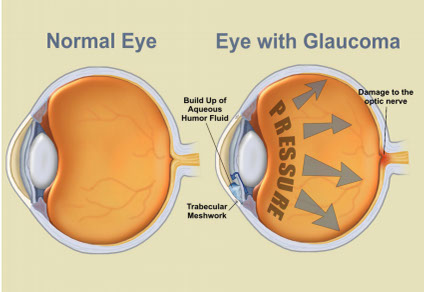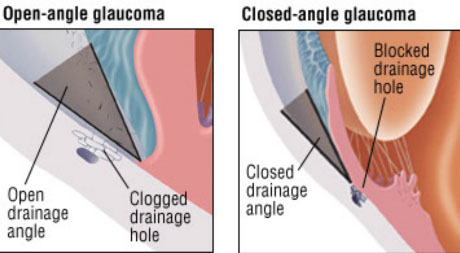EYES
KNOW YOUR
Glaucoma
Introduction
Glaucoma is a term that describes a group of eye conditions that affect vision. Glaucoma often affects both eyes, usually in varying degrees. One eye may develop glaucoma quicker than the other.

Figure : Normal eye & eye with Glaucoma
Glaucoma occurs when the drainage tubes (trabecular meshwork) within the eye become slightly blocked. This prevents eye fluid (aqueous humour) from draining properly.
When the fluid cannot drain properly, pressure builds up. This is called intraocular pressure. This can damage the optic nerve (which connects the eye to the brain) and the nerve fibres from the retina (the light-sensitive nerve tissue that lines the back of the eye).
Types of Glaucoma
There are four main types of glaucoma
► Chronic open-angle glaucoma – this is the most common type of glaucoma and develops very slowly
► Primary angle-closure glaucoma– this is rare and can occur slowly (chronic) or may develop rapidly (acute) with a
sudden, painful build-up of pressure in the eye
► Secondary glaucoma– this occurs as a result of an eye injury or another eye condition, such as uveitis
(inflammation of the middle layer of the eye)
► Developmental glaucoma (congenital glaucoma) – this is rare but can be serious. It is usually present at birth or
develops shortly after birth. It is caused by an abnormality of the eye).

Figure : Open & Closed-angle glaucoma
Signs & Symptoms
The signs and symptoms of primary open angle glaucoma and acute angle-closure glaucoma are quite different.


Figure : How a person with healthy eye vision sees
Figure : How a person with advanced vision loss from glaucoma sees the same thing
Signs and symptoms of primary open-angle
glaucoma
• Peripheral vision is gradually lost. This nearly always affects
both eyes
• In advanced stages, the patient has tunnel vision
Signs and symptoms of closed angle glaucoma
• Eye pain, usually severe often accompanied by
nausea, and sometimes vomiting
• Blurred vision
• Lights appear extra halo-like glows around them
• Red eyes
• Sudden, unexpected vision problems, especially
when lighting is poor
Risk Factors
• Increasing age
• African-American heritage
• High blood pressure
• Long-term steroid treatment
• Family history
• Diabetes
• Nearsightedness
• Eye injuries
Treating Glaucoma
Glaucoma can be treated with eye drops, laser treatment or surgery. However, early diagnosis is important because any damage to the eyes cannot be reversed. Treatment aims to control the condition and minimize future damage.
If left untreated, glaucoma can cause visual impairment. But if it is diagnosed and treated early enough, further damage to vision can be prevented.

LOCATION
Ipoh
23-27 Jalan Kamaruddin Isa
(Jalan Fair Park)
31400 Ipoh Perak
Malaysia
Taiping
27 Jalan Medan Taiping 5
Taman Medan Taiping
34000 Taiping Perak
Malaysia
CONSULTATION HOURS
Ipoh
Mon., Tue. & Fri. : 2.00 pm - 5.00 pm
Wed. & Thurs : 9.00 am - 1.00 pm
Sat. : 9.00 am - 12.00 pm
Taiping
Monday : 8.30 am - 1.00 pm
Wednesday : 2.00 pm - 4.00 pm
Saturday : 2.30 pm - 6.00 pm
© 2015 All Right Reserved, Chew Eye Specialist & Surgery Sdn. Bhd.
